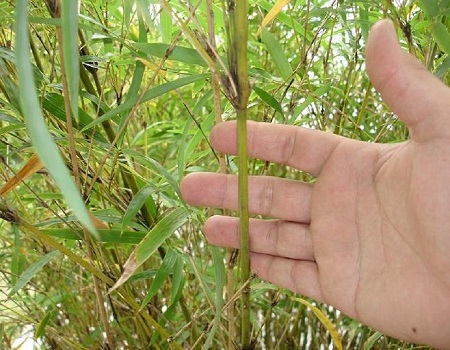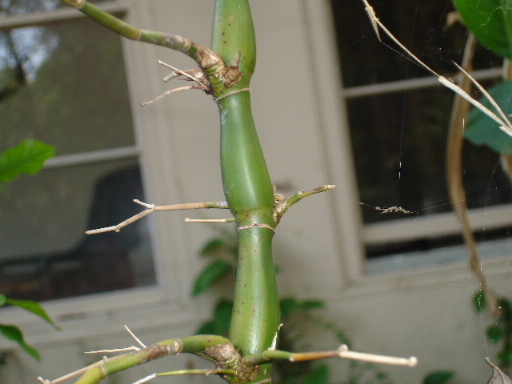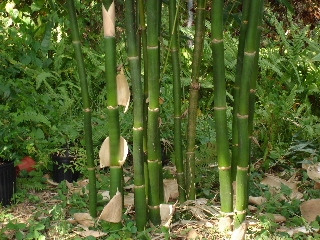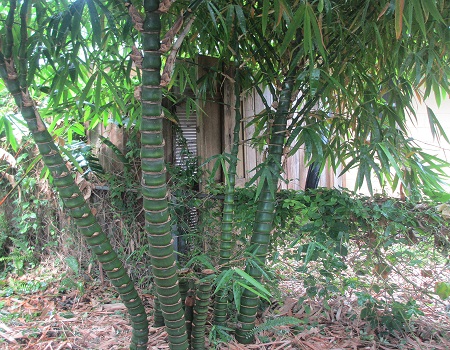Bamboo
Majestic bamboo plants. Natures living wind chimes. Tall and graceful, bamboo plants can be some of the most rewarding and beautiful additions to any garden. They range from low bushy hedges to towering tropical giants over a hundred feet high with 12″ diameter canes. They impart an Asian feel to any garden, and they can be used quite dramatically to create separate spaces within a garden.
Runners Versus Clumpers
The most common question I receive about bamboo is: “how do you keep it from spreading?” The simplest answer is… you don’t. Bamboo that wants to spread, will spread no matter what you do. People try to place barriers around them, but they will find a way. They will grow through brick walls, under cement walkways, through the holes in the bottoms of pots. There is however good news! Not all bamboo runs. All bamboo plants can be placed into one of two broad categories: runners, and clumpers. STAY AWAY FROM RUNNING VARIETIES.
Running Bamboo
If you plant a running variety in your back yard, it will come up all over your back yard, and in your front yard, and in your neighbor’s yards, making enemies out of them. The shoots wreak havoc on lawnmower blades, which usually cut them at an angle creating pointy little bamboo spears throughout your lawn, making barefoot walking a bad idea. Some people break the shoots off as they come up in areas they don’t want them growing, which will keep them somewhat contained, but running bamboos concentrate so much energy on underground growth that nutrients are quickly depleted from the area they are being contained to, without a lot of above ground growth. If you see a beautiful specimen of a Japanese black bamboo (phyllostachys nigra), which is admittedly stunning, and think, “I must have one in my yard”, know that you have been warned. I always love how people who sell this plant refer to it as being “less invasive” than common bamboo. I do not grow running varieties. I do not sell running varieties. So this pretty much ends my discussion of them.
Clumping Bamboo
Clumping bamboo plants are in my opinion the only way to go. The new shoots never come up any farther than five or six inches away from the older shoots, so the clump of canes grows slowly wider over time. If you want a larger area planted with them, or if you want a privacy screen, plant more individual plants, or over time divide your specimen, and replant. Clumping varieties can grow quite quickly, they just wont take over your yard. One of my favorite varieties is Oldham’s bamboo. If you like Phylostachys nigra, and you want a bamboo with black canes, Timor black bamboo is a tropical clumping variety that is a good substitute. Another unusual variety is, Bambusa vulgaris “wamin”. The canes bulge out between the nodes giving it a very attractive knobby appearance, referred to as the buddha belly form of Bambusa vulgaris. This is not to be confused with buddha belly bamboo. If you just want a privacy screen or a dense short hedge Bambusa multiplex is a very easy plant to grow.
Bamboo Blooming
Bamboo blooming events are one of the most interesting mysteries of the plant world. Little is known about the flowering of most bamboo species, due mostly to the fact that bamboo rarely blooms. Being grasses, and not actually trees, bamboo is anemophilous (pollinated by wind). Bamboo flowering can be broken into three broad categories: frequent, infrequent, and gregarious (very infrequent, and all at the same time). In general, the more frequently a bamboo blooms, the fewer viable seed are produced, and the parent plant will sustain less damage. Gregarious bloomers sometimes bloom as infrequently as once every century. This type of blooming event usually results in the death of every adult plant in the population. This can be devastating to communities (both human and ecological) relying on these plants, as it can take many years for the seedlings to mature. In light of this, it is not a good thing when the prize specimen in your garden begins to bloom. Often, a bamboo will recover from blooming without doing anything special, but frequently they do die. I have heard of strategies for saving a blooming bamboo, but I have never had to try any of them. Cutting off the blooming canes as soon as you see them, and heavy watering/feeding is supposed to work, but I’ve never been able to reliably verify the efficacy of this. If your bamboo plant does bloom, and you choose to let it run its course, collect the seeds and sow them. It may be the only way to keep your plant.
Selecting a Bamboo Plant
When selecting a clumping bamboo specimen for your yard, vertical height, cane size, and gardening zone are the three most important things to consider. Once you decide which species best suits your needs, don’t make the mistake of buying the largest, most mature specimen thinking it will be full sized in less time than a smaller younger one. Bamboo becomes highly root bound when it is grown in a container for too long, which dramatically stunts its growth. It can take a year or even two for a larger specimen to begin growing at a normal pace. A smaller specimen will catch up to the larger one, and even surpass it within two years. Large bamboo specimens are VERY expensive. Save your money, go with the one-gallon size. If you are in zone 8 or lower, many of the cold tolerant clumpers (i.e. Fargesia, Chusquea, and Borinda species) require shade. If you have full sun, Thamnocallamus tessellatus is a good choice. In zone 9 or higher, you really can,t beat the Bambusas. Oldham’s bamboo is my favorite for when you want tall large culms. When you want a low tight hedge, Bambusa multiplex is an excellent choice.
Planting
Dig the hole for planting twice the size of the root ball of the plant. Back fill the hole with a good topsoil that’s high in organic matter. Adding some composted cow manure to the soil is beneficial as well. Mulch added around the base will help to keep the newly planted bamboo from drying out during this critical period. Eventually, bamboos mulch themselves with their own leaves, but if you prefer to rake the leaves up, continue to mulch annually. Do not allow newly planted bamboo plants to dry out.
Watering
When newly planted, water bamboo frequently. Lack of water is the most common reason for bamboo to fail. If the leaves curl up, it needs water immediately. It’s hard to overwater most species of bamboo, but standing water is not good for them, and can cause the rhizome to rot. If the leaves begin to turn yellow, overwatering may be the reason. Many species of bamboo, once established, are frequently very drought tolerant, but lack of water will cause growth to be stunted.
Pruning Bamboo
Bamboo benefits from being pruned annually to thin out the stand. Only remove canes that are older than one year old. When canes turn yellow/brown, they are dead and need to be removed. This also creates an opportunity for all sorts of crafts and building projects… Tiki Bar!!! Personally I prefer their natural form, but bamboo can also be trimmed into a hedge, and some species can even be used for topiary.
Bamboo Pests
I’m told that gophers and ground squirrels will eat the fresh young shoots. Luckily I don’t have these vermin here. Protect young plants with hardware cloth buried in the ground around young plants. Once they get large enough, all is good. I have a problem with ants farming scale insects on the culms. Insecticide spray kills the scale insects but the ants just bring more. I declared war on the ants instead! I use granular ant poison. Controlling ants, frequently controls aphids, mealy-bugs, and scale insects. This works for almost any plant you see ants on. Don’t underestimate ants. Even when they seem to be harmless, they’re farming pests. Kill them.





